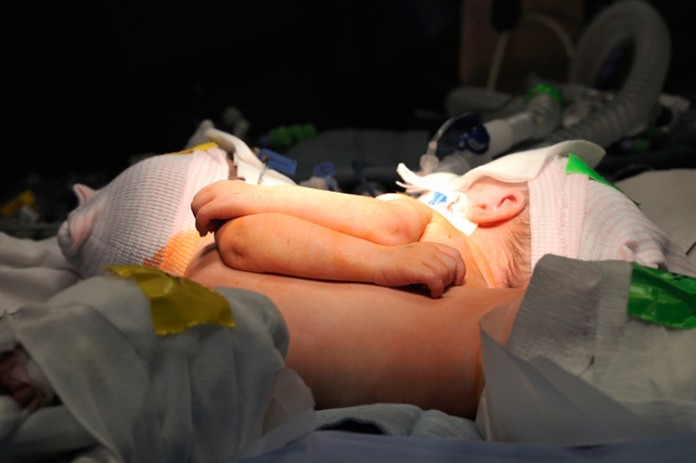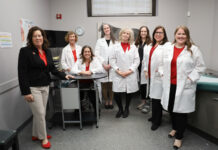
Specialists with University of Louisville Physicians have announced they performed a surgery to separate 7-week-old conjoined twin girls on Nov. 11 at Kosair Children’s Hospital. Since the surgery, the girls have been under close watch of experts in the hospital’s “Just for Kids” Critical Care Center. They are currently still on ventilators but have been getting stronger by the day. Their long-term prognosis is not yet known, but indicators are favorable for continued improvement.
“In any situation where you have so complex a surgery, there is always a long road to recovery,” said Erle H. Austin III, MD, pediatric surgeon with UofL Physicians and the UofL School of Medicine’s Department of Cardiovascular Surgery. “We are cautiously optimistic, as one or both may require additional surgeries in the future.” Austin also is chief of cardiovascular surgery at Kosair Children’s Hospital.
“God was definitely watching over the girls and the medical team on the day of the surgery,” said the babies’ mother. “We are so thankful to God and everyone at Kosair Children’s Hospital for getting them this far.
“We are also thankful to the hospital chaplain, who prayed with us before the delivery and the day of the surgery.”
The twins were born at Norton Hospital and had been under close watch of UofL Physicians’ neonatologists in the Kosair Children’s Hospital Level IV neonatal intensive care unit.
The twins were defined as thoraco-omphalopagus, which means their bodies were joined at the chest and abdominal cavity. Their livers were joined and they shared some of the same heart structures.
Conjoined twins occur in approximately one out of 200,000 live births. Forty to 60 percent are stillborn, and about 35 percent survive only one day. The overall survival rate of conjoined twins is between 5 percent and 25 percent.
The surgical team waited as long as possible prior to performing the separation surgery. The decision to operate was made after the twins began to need increased breathing support. They also were not growing as they should. One of the infants was more fragile than the other, and survival was in question. The separation procedure was risky for both.
While originally expected to last about 12 hours, the procedure went smoothly and was completed in approximately eight hours. To prepare, the surgical team had undergone multiple drills using dolls.
The UofL Physicians’ medical team involved in the procedure included two cardiovascular surgeons, a transplant surgeon, a plastic surgeon, two pediatric surgeons, a pediatric surgery fellow and a cardiologist. Other specialists included two additional plastic surgeons, three anesthesiologists, a radiologist, extracorporeal membrane oxygenation specialists, advanced surgical nurses, surgical technologists, biomedical and engineering specialists, information systems technologists, respiratory therapists and blood bank team members. In all, more than 45 people were involved in the planning and surgery. More have been involved in the babies’ care throughout their stay.

































